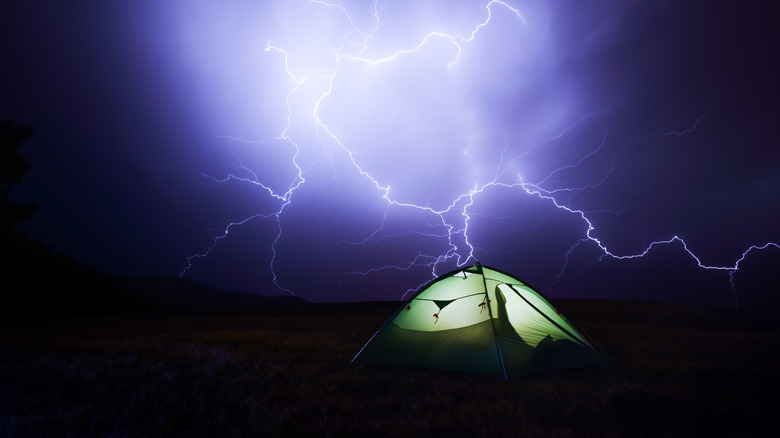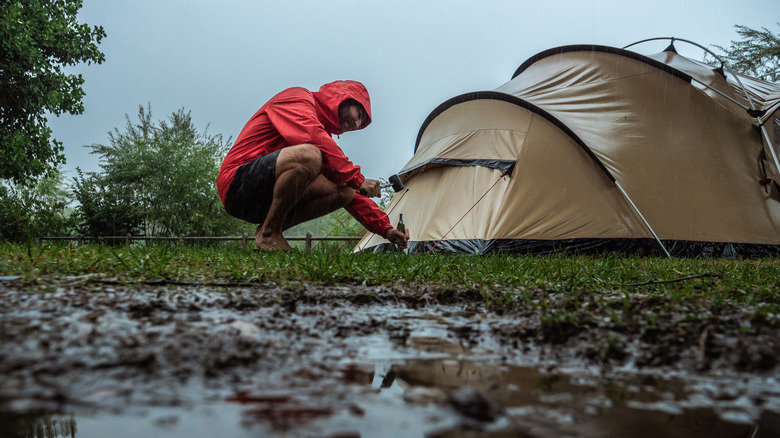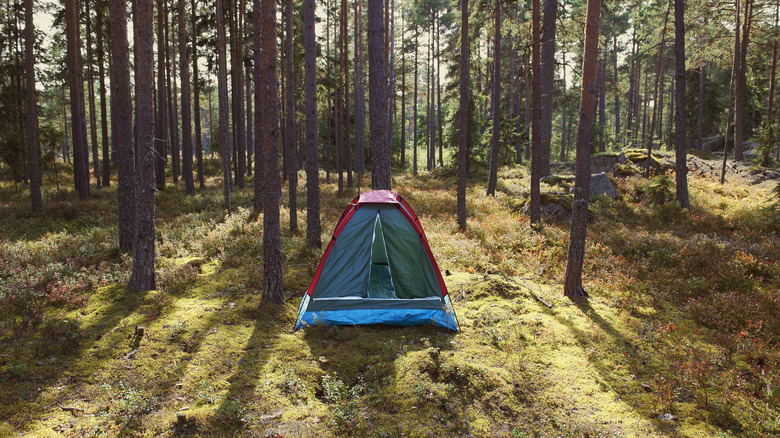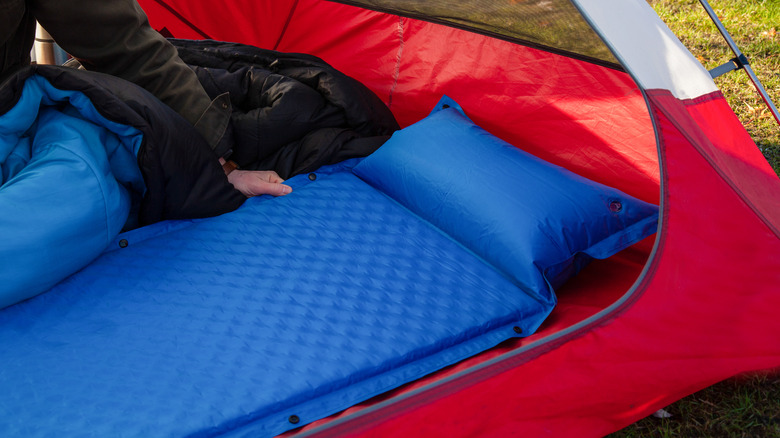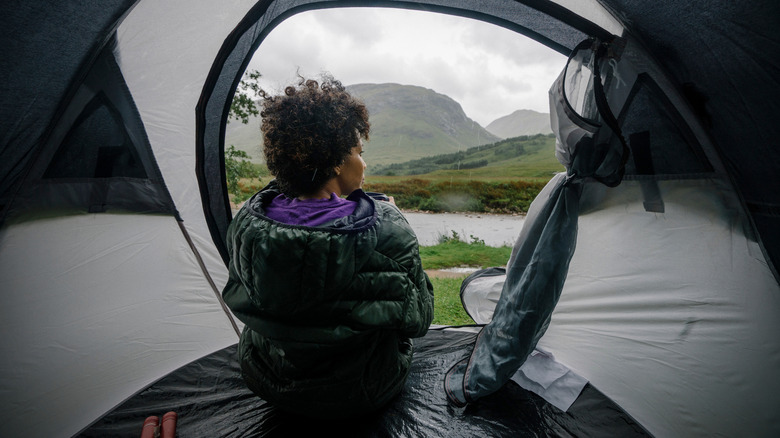How To Protect Yourself When Tent Camping During A Thunderstorm
Camping in a thunderstorm is never a fun experience, and it tends to make you appreciate how much protection a solid structure like your home provides. Because the weather can change quickly out in the wilderness, it is important to know what you can do to protect yourself while camping in a thunderstorm. This is especially true because a tent is not the safest place to be during a storm, and it's even more unsafe if there is lightning.
In general, if you are camping and the sky turns menacingly dark or if a storm cell suddenly pops up on the radar, the safest thing to do would be to find another shelter before the storm hits. The best places to wait out a storm include any fully enclosed buildings with electricity or plumbing (like a ranger station, bathroom, cabin, or shelter) or any vehicle that's fully enclosed in metal and doesn't have a cloth top (if you do sit in a car, don't touch anything metal inside).
If these options are unavailable, then you will need to rough it out through the storm in your tent. Luckily, there are a few things you can do to make your thunderstorm camping experience as safe and comfortable as possible.
Choose the best tent
The biggest issue with camping during a thunderstorm is that tents don't provide any sort of protection from lightning. While getting struck by lightning in the wilderness is pretty rare, it still does happen and it is important to protect yourself just in case.
If your tent has a metal frame and poles, it's not the end of the world because metal doesn't attract lightning so it won't make you more likely to get struck. However, metal is good at conducting electricity and you will want to avoid touching any metal inside your tent during the storm. Because of this, if you are planning to camp in an area that experiences frequent storms (like in the mountains or desert), then you may want to invest in a tent with a plastic frame just to cover your bases.
You will also want to make sure you buy a tent that is waterproof and not just water-resistant. Luckily, most tents nowadays are waterproof and will provide adequate protection from light rain. However, as tents go through wear and tear, they may start to spring leaks — especially through the seams. To prevent this, you will need to regularly waterproof and seal your tent. If you are out in the rain and your tent is leaking, you can try and patch up leaks using duct tape.
Pick a safer location
When choosing a place to pitch your tent, you should always consider whether or not the location will be safe during a thunderstorm and try to choose an area that offers some protection without exposing you to lightning and other hazards. In general, you don't want your tent to be the tallest thing around. You also don't want to be camped right next to the tallest thing around (whether that's a tree, bush, cactus, or telephone pole).
This means you will want to avoid clearings and ridges, and instead try to set up in a valley or under the treeline. However, if you decide to pitch your tent in the forest under trees, you need to look up and check for any signs of decay that indicate a tree is dead or unhealthy. Also, keep an eye out for dead branches that could fall during high winds. This is important because dead branches can be extremely dangerous and could collapse your tent and cause serious injury.
While heading into a valley or low-lying area is a good idea to make your campsite safer from lightning strikes, if the valley contains a river or other body of water you will want to avoid it. In fact, the CDC recommends staying at least 100 yards away from water during a storm because water (like metal) is a great conductor.
Protect against high winds
Other than lightning and flash floods, the most dangerous thing a storm can cause is high wind. This is because high winds can not only bring down tree branches and send your gear flying but they can also collapse your tent. And, the only thing that is more miserable than being in a tent during a storm is being in a collapsed tent during a storm. So, how can you protect your tent from falling in on you? Luckily, if you have some time before the storm hits, you can take a few extra precautions to make sure your tent is stable.
The first thing you should do is make sure you use all of the tent's ropes and stakes and have not missed any important tie-downs. Tent stakes are the most stable and hold the strongest when hammered into the ground at a 90-degree angle – or vertically — (despite what some sites claim about 45-degree angles). Furthermore, when setting up your tent, you should face the smaller or thinner part into the wind so that your tent is a little more aerodynamic. If possible, you may also want to pitch the tent behind some kind of wind blocker like a vehicle, boulder, or ridge to give yourself some extra protection.
Put something between you and the ground
When camping in a storm it is also important to put something between you and the ground to help protect you both from water and lightning strikes. To prevent water from seeping into your tent from the wet earth below, it's a good idea to put a tarp underneath your tent for some extra protection and waterproofing. This will help keep you and your gear dry after heavy rainfall. Just make sure that your tarp is the same size or smaller than your tent so that water doesn't collect on the tarp and start pooling between your tent and the tarp.
On top of this, for some extra protection against water and insulation against lightning strikes, you should sit on a foam sleeping pad or yoga mat. This will help keep you dry while you ride out the storm. Furthermore, the material used to make these types of mats is not conductive and will help protect you if lightning strikes the ground nearby. If you don't have a foam pad, you can also crouch on a backpack or anything else that gets you up off the floor. While it may be tempting to lie down and make yourself comfortable, if there is lightning nearby, the safest position to be in is squatting with your feet together and as little of your body as possible touching the ground.
Stay dry and warm
Besides the risk of getting struck by lightning or hit by a flying object, the most dangerous aspect of being caught in a storm is getting wet. This is because being wet causes your body to lose heat more quickly, making you more likely to develop hypothermia. In fact, according to the CDC, while you are at a greater risk of developing hypothermia in below-freezing temperatures, it can also develop in weather above 40 degrees Fahrenheit if a person has been exposed to cold rain and wind and is wearing wet clothing.
So, to prevent this, it is important to stay dry. You can do this by putting on all of your waterproof clothing (such as rain jackets and ponchos) and by wearing insulated layers. If your tent is leaking and you know you will get wet, you can also quickly store some dry clothing in a plastic garbage bag. This way, when the storm subsides, you can remove your wet clothes and change into your plastic-protected dry clothing to help warm yourself up again.
